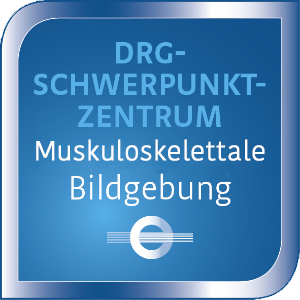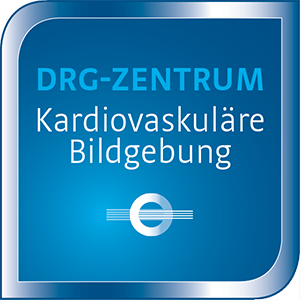Procedure for nuclear medicine exam
Procedure for nuclear medicine exam
What do I need to consider?
Please remember your referral slip, and bring any previous diagnoses and images with you, if possible.
Typically you do not need to make any special preparations for a nuclear medicine exam. For exams of the thyroid, the heart muscle, or the kidneys, a few rules must be followed. They are listed in a separate part and will be provided to you when you register for the exam.
More detailed information about each exam can be found in the following overview.
Thyroid scintigraphy provides information about the activity and distribution of thyroid functions within the thyroid gland.
Indication: thyroid nodules and/or hyperthyroid function, establishing or ruling out functionally relevant autonomy, check of progression of untreated autonomy, previously planned radioiodine therapy or OP, therapy check after radioiodine therapy, differentiation of autoimmune thyreopathy (e.g., Hashimoto disease, M. Basedow disease).
Preparation: If you take thyroid medications, and/or have recently been exposed to iodine (e.g., for computed tomography using contrast agent), we ask that you let us know. Any exam using iodine should be 6-8 weeks in the past, if possible.
Procedure: You will have a small amount of a weakly radioactive substance (Technetium-99m-pertechnetate) injected into a vein in the arm. The substance takes about 20 minutes to spread out, then images are taken with a gamma camera for 10 minutes. If needed, an ultrasound exam of the thyroid may be performed beforehand or afterward.
Time required: about one hour altogether
Myocardial scintigraphy captures the blood flow in the heart muscle under stressed and unstressed conditions.
Indication: ruling out relevant blood flow problems for an elevated risk profile, or if sufficient bicycle ergometric stress cannot be established or interpreted (e.g., left bundle branch block), abnormal stress ECG, assessment of relevance for known constriction of the coronary arteries, therapy progression monitoring, prior to a major planned surgical intervention.
Preparation: Before the stress test, you should fast, should not have taken heart pills, and should not have had any caffeinated beverages for while (this information will be provided separately prior to the exam.) Before the unstressed exam, you should have taken your pills.
Procedure: You will almost always first be examined under stress conditions, that is, you will need to ride an ergometer bike, just like for a stress ECG. Or you may receive medication through a vein in the arm that “simulates” stress on the heart. In this case you will also ride a bike, but at a lower resistance level. At the time of maximum stress, we inject the weakly radioactive substance through a vein in the arm, which then distributes itself through the blood flow in the heart muscle. About one hour later, the images are taken with a gamma camera, which takes about 15 to 20 minutes.
Depending on the results of the exam, and your known findings, an exam under unstressed conditions may be needed. You will have the same weakly radioactive substance injected again, then wait about an hour, then the images will be recorded with the gamma camera.
Time required: The exam is usual done over two days. The stress test takes about 2 hours, and the unstressed test takes about 1.5 hours. In rare cases, both exams can be performed on the same day, which takes about 3 to 4 hours.
In bone or skeletal scintigraphy, the bone metabolism is captured. Bone metabolism changes with inflammation and tumors in the bone and the joints, as well as in cases of bone metastasis.
Indication: bone metastasis, bone tumors, osteomyelitis, TEP slackening, joint inflammation, questions after rheumatic disease, bone necrosis, bone infarction, unrecognized fractures, M. Sudeck, evaluation of metabolic activity prior to pain therapy using samarium.
Preparation: none
Procedure: A weakly radioactive substance will be injected into a vein in the arm. Depending on the issue, images will be taken with a gamma camera directly afterward for about 5 to 10 minutes and/or after about 2 hours of waiting time. During the waiting period, you will need to drink at least one liter of fluid. You can eat or drink anything except for milk and dairy products. Take your pills as usual. The subsequent late imaging, typically of the entire body (full-body scintigraphy) takes about 15 to 20 minutes. For some issues, layer images (SPECT) may also be needed, which takes 20 to 30 minutes.
Time required: about 3 hours
Kidney function and urination can be shown on separate sides.
Indication: Establishing total tubular function (clearance), separate side functional portions of both kidneys, clarification and progression monitoring for urinary problems.
Preparation: Drink sufficient fluids prior to the exam.
Procedure: After it has been determined that you have had sufficient fluid intake, you will be placed in a lying position on the gamma camera. You will have a weakly radioactive substance injected into a vein in the arm (radiopharmacon), and the images will be captured by the gamma camera for 30 to 40 minutes. Within this time period, blood will be taken twice in order to measure the function of kidneys. You will also receive a diuretic medication in order to overcome any difficulties passing urine. This information is important for assessing the relevance of any difficulty urinating. You must remain lying still while the gamma camera captures the images.
Time required: about 1 to 1.5 hours
Depending on the radiopharmacon used, blood flow in the lungs can be captured.
Indication: Establishing or ruling out pulmonary arterial embolism (perfusion scintigraphy) Preoperative quantitative assessment of lung function in individual segments of the lung.
Preparation: none
Procedure: for perfusion scintigraphy, weakly radioactive protein particles are injected into a vein in the arm and briefly remain in the tiniest lung capillaries, comparable to an embolism that is irrelevant to the body (capillary blockage), and are then quickly broken down. Immediately after injection, images of the lungs are taken from six or eight viewpoints, sometimes using SPECT, which indicate the distribution of the substance and thus provide an image of the blood flow in the lungs.
Time required: about 1 to 1.5 hours
3 X IN BADEN-BADEN
Medical Center
Beethovenstraße 2
76530 Baden-Baden
Acura-Kliniken (ehem. Rheumaklinik)
Rotenbachtalstraße 5
76530 Baden-Baden
Klinikum Mittelbaden Baden-Baden Bühl
Klinik Balg
Balger Straße 50
76532 Baden-Baden





